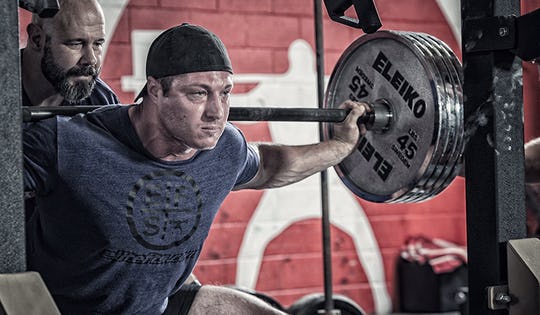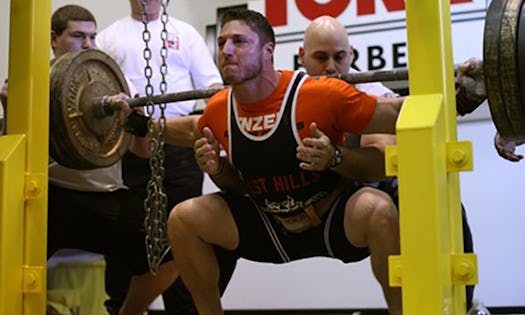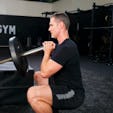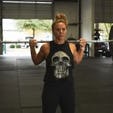The squat is the king of all power building, athletic movements. You don’t have to kneel before the king, but some days you may feel that way after a grueling squat workout.
What can it do for you? Well, besides building your entire posterior chain, it can shape your core, quads, glutes, etc. I’m talking to you ladies!
I’ve Never Squatted Before. How Do I Squat?
Keep in mind these are the basics.
There are a lot of other cues that weightlifters will use to help lock in their technique, but for the purpose of this article I would like to keep it relatively simple.
Even if you’re proficient with goblet or other kettlebell squats, you may feel awkward squatting with a bar on your back if it’s not part of your normal routine.
The goblet squat is more like a front squat, where the bar is positioned across your shoulders and clavicle.
A barbell squat or back squat changes the leverage.
Placing the bar on your back loads the spine differently than the goblet or front squat.
Key Points to Proper Squats
● Most people are going to place their feet anywhere from shoulder width to just outside shoulder width apart. Depending on hip mobility, it is advantageous to point your toes out 30-45 degrees.
● The glutes should be fired up and ready to go, assuming your warm up takes care of that. Goblet squats, overhead squats, bodyweight squats, bird dogs, and Kettlebell swings can help with warming up your gluten before a squat set.
● Keep the natural curve in your low back to maintain the integrity of the spine. Brace your abs. Take a deep breath before unracking the bar, and then between each rep take another breath. The key to this is to breath into your belly, filling your abs and obliques moreso than your
chest. If you wear a weight lifting belt, imagine you are trying to push your abs through your belt. It should be uncomfortable, but it will make you stronger and more stable for your squats. This applies to any type of squat, even bodyweight squats.
● Find the natural shelf on your back where the bar feels most comfortable. Once you let the bar settle on your back point your elbows down and flex your lats, as if you were doing a pull up. This will help stabilize your core as well. One mistake beginners make here is keeping their
elbows and lats relaxed.
● If your elbows are pointed backwards rather than down, you are driving yourself forward, making it difficult to drive out of the bottom of your squat. By keeping your elbows down you can maintain an upright torso and more efficiently transfer force from your lower half into the
bar.
● Hands should be just outside the shoulders, but this will depend on shoulder mobility. Usually the closer you can get them, the better. Squeeze the bar as hard as you can!
● Finally, keep your head in a neutral position, not cocked way back and not looking into the ground. Find a point just above the horizon and stay focused on that.
3 Essential Squat Cues
Squat Cue #1: Suck in Air!
Fill your belly with air and brace your core.
Squat Cue #2: Get Your Butt Back!
Most beginners will hinge at the knees first. It’s the most natural movement and it’s how we all sit on the toilet. This puts a lot of stress on the patella tendon, part of the reason that people complain of knee pain from squats, and it doesn’t allow your biggest muscles in the posterior chain to properly engage.
So your first movement in the squat should be to push your hips back. This will keep your knees from tracking too far over the toes and will actually allow you to squat more weight with practice.
Squat Cue #3: Drive Your Shoulders into the Barbell!
In the bottom of your squat think about driving your shoulders up and back.
This will prevent you from driving your hips too early and putting the bar up over your toes…leaving you in the ‘good morning’ position with a sore back.
If you are not confident to jump into this movement, there is a great alternative. Box squats. In both a free squat and a box squat you want to be able to work to the point where your thighs are parallel to the ground.
But, a box squat will allow a beginner to understand what proper depth is. They’ll be more comfortable pushing their hips back and sitting to the box instead of hinging at the knees and sitting straight down.
Well alright, alright, alright. I want to squat. How do I program a squat workout? The options are endless, but here are a couple of very basic programs that anyone can follow.
How to do Squats Option 1
| Sets x Reps | % of 1 rep max | Ex. 200# Squatter | |
| Week 1 | 3×10 | 65 | 135 |
| Week 2 | 3×8 | 70 | 140 |
| Week 3 | 3×6 | 75 | 150 |
| Week 4 | 3×4 | 80 | 160 |
| Week 5 | 3×3 | 85 | 170 |
| Week 6 | 3×2 | 90 | 180 |
| Week 7 | 3×1 | 95 | 190 |
| Week 8 | 1RM | 100+ | 200+ |
● A very simple and effective program for beginners.
How to do Squats Option 2
| Sets x Reps | % of 1 rep max | Ex. 400# Squatter | |
| Week 1 | 4X8 | 60 | 240 |
| Week 2 | 4X7 | 65 | 260 |
| Week 3 | 4X6 | 70 | 280 |
| Week 4 | 3×5 | 50 | 200 |
| Week 5 | 3×5 | 75 | 300 |
| Week 6 | 3×4 | 80 | 320 |
| Week 7 | 3×3 | 85 | 340 |
| Week 8 | 3×5 | 50 | 200 |
| Week 9 | 3×2 | 90 | 360 |
| Week 10 | 3×1 | 95 | 380 |
| Week 11 | 1RM | 100+ | 400+ |
● Similar program numbers wise, but the key difference is the incorporated deloads (weeks 4 and 8). This is beneficial for a more advanced squatter who is moving heavier weights. The body needs more time to recover from the heavier loads, so the rest weeks are essential.
How to do Squats Option 3
| Sets x Reps | % of 1 rep max | Ex. 500# Squatter | |
| Week 1 | 5X5 | 65 | 325 |
| Week 2 | 4X4 | 70 | 350 |
| Week 3 | 5X1 | 50 | 250 |
| Week 4 | 5X5 | 70 | 350 |
| Week 5 | 4X4 | 75 | 375 |
| Week 6 | 5X1 | 50 | 250 |
| Week 7 | 3×3 | 75-80-85 | 375-400-425 |
| Week 8 | 3×2 | 85-90-95 | 425-450-475 |
| Week 9 | 5X1 | 50 | 250 |
| Week 10 | 3X1 | 90-95-100 | 450-475-500+ |
● This is for a more advanced squatter, but still shows a similar progression with some added recovery weeks.
Photography By: Inky Byers, Ken Hicks and Elite FTS.



)





